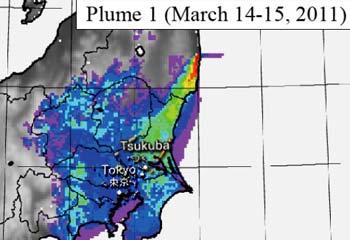
200,000,000,000,000 becquerels/kg in fuel rod materials found near Tokyo… “the material spread globally” — Composed “major part” of worst Fukushima plume — Persists for long time in living organisms — Must reconsider disaster’s health effects (PHOTOS)
ENE News
Presentation by Yasuhito Igarashi of Japan’s Meteorological Research Institute at IAEA’s expert meeting (pdf), Characteristics of Spherical Cs-Bearing Particles Collected during the Early Stage of FDNPP Accident, February 2014: […] We have found spherical Cs-bearing particles (Cs-ball) from HV filter samples collected during Mar. 14-15, 2011, when the first radioactive plume arrived from the FDNPP accident at the MRI [Meteorological Research Institute] as well as Univ. Tsukuba, Japan. […] experiments showed that the Cs-ball occupied major part in the Mar. 14-15 Fukushima plume. They would persist for a long time in the environment as well as in living organisms. […] the investigation on radioactive aerosol during the second plume arrival gave no such Cs-ball. […] The finding should be a key to understand the processes of  the FDNPP accident, to accurately evaluate the health and environmental impacts and to improve efficiency of the decontamination of the polluted area. […] Further studies are recommended for the present Cs-ball in more detail!
the FDNPP accident, to accurately evaluate the health and environmental impacts and to improve efficiency of the decontamination of the polluted area. […] Further studies are recommended for the present Cs-ball in more detail!
- Particle 5: 0.2 TBq/g (200 trillion Bq/kg)
- Additional research on spherical particles: Nuclear fuel found 15 miles from Tokyo suburbs — Fukushima uranium in ‘glassy’ spheres transported over 170 km
Scientific Reports (Nature Publishing Group) — Emission of spherical cesium-bearing particles from an early stage of the Fukushima nuclear accident, Aug. 30, 2013: The Fukushima nuclear accident released radioactive materials into the environment over the entire Northern Hemisphere […] Although the  accident has global impacts, we still do not know exactly what happened in the reactors […] The chemical and physical properties of the radioactive materials released into the environment are not well known. Such knowledge is necessary to improve the numerical models to estimate the geographical distributions and evaluate the human exposures [...] released radioactive material [...] was spread globally [...] We collected aerosol samples [...] at the Meteorological Research Institute, Tsukuba, Japan, which is located 170 km southwest of FNPP [...] The spherical Cs-bearing particles likely have longer retention times on the land surface than those of the water-soluble Cs particles. The retention time of the particles in the soil or other environments needs to be reconsidered. The health effects of the particles should be evaluated [...]
accident has global impacts, we still do not know exactly what happened in the reactors […] The chemical and physical properties of the radioactive materials released into the environment are not well known. Such knowledge is necessary to improve the numerical models to estimate the geographical distributions and evaluate the human exposures [...] released radioactive material [...] was spread globally [...] We collected aerosol samples [...] at the Meteorological Research Institute, Tsukuba, Japan, which is located 170 km southwest of FNPP [...] The spherical Cs-bearing particles likely have longer retention times on the land surface than those of the water-soluble Cs particles. The retention time of the particles in the soil or other environments needs to be reconsidered. The health effects of the particles should be evaluated [...]
Published: August 11th, 2014 at 1:41 pm ETBy ENENews |
